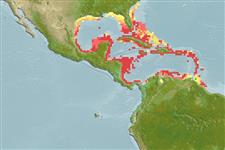Common names from other countries
Classification / Names / Names
Namen | Synonyme | Catalog of Fishes (gen., sp.) | ITIS | CoL | WoRMS
Environment: milieu / climate zone / depth range / distribution range
Ökologie
; tiefenbereich 0 - 58 m (Ref. 848). Subtropical; 33°N - 8°N, 98°W - 58°W (Ref. 848)
Western Atlantic: Gulf of Mexico, Caribbean Sea and Bermuda.
Length at first maturity / Size / Gewicht / Alter
Maturity: Lm ? range ? - ? cm
Formation: solid, rounded, often circular plates. Valleys: continuous, broad, shallow but sometimes deep; radiating from the original point of growth; with one row of mouths; short walls possible. Septo-costae possibly thinner than intervening spaces. Corallite centers: vaguely concentric to plate margins. Rudimentary or absent columellae. Color: often mottled gray or brown; also combinations of pink, green, and gray, with valleys and walls of contrasting colors (Ref. 848).
Maximum depth from Ref. 116012. Zooxanthellate (Ref. 116012). Occurs in most reef environments (Ref. 848).
Life cycle and mating behavior
Geschlechtsreife | Fortpflanzung | Ablaichen | Eier | Fecundity | Larven
Members of the class Anthozoa are either gonochoric or hermaphroditic. Mature gametes are shed into the coelenteron and spawned through the mouth. Life cycle: The zygote develops into a planktonic planula larva. Metamorphosis begins with early morphogenesis of tentacles, septa and pharynx before larval settlement on the aboral end.
Cairns, S.D., D.R. Calder, A. Brinckmann-Voss, C.B. Castro, D.G. Fautin, P.R. Pugh, C.E. Mills, W.C. Jaap, M.N. Arai, S.H.D. Haddock and D.M. Opresko. 2003. (Ref. 1663)
IUCN Rote Liste Status (Ref. 130435)
CITES Status (Ref. 108899)
Not Evaluated
Nutzung durch Menschen
| FishSource |
Tools
Mehr Information
Alter/GrößeWachstumLänge-GewichtLänge-LängeMorphologieLarvenDichte
Internet Quellen
Estimates based on models
Preferred temperature
(Ref.
115969): 25.3 - 28.1, mean 27 (based on 148 cells).
Preiskategorie
Unknown.
